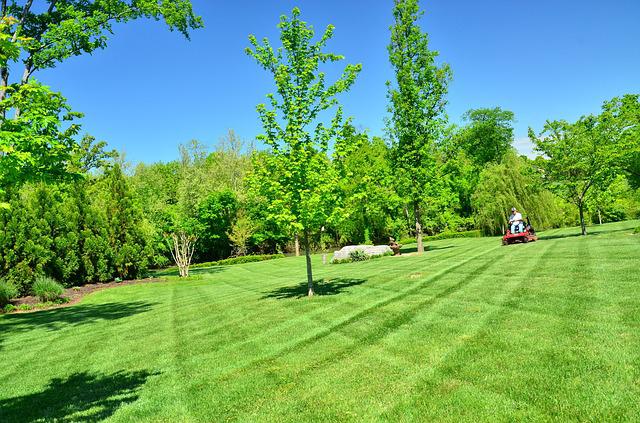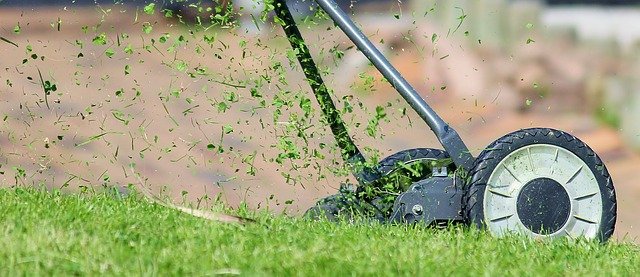Mowing Tips for a Beautiful Healthy Lawn

Lawns waste a lot of water and take a lot of time, energy, and expense. However, most people are not willing to totally convert all their lawn area to hardscape and ornamentals. Mowing is just something that must be done if you want your home to look beautiful. Think of mowing as good exercise and a chance to get out in the fresh air and sunshine. With the little bit of rain we have been blessed with recently this spring, the lawns are growing quickly. The problem is to let the grass and soil dry enough to mow without causing damage and still not let the grass get too tall before the next mowing.
Make sure the lawnmower is in good condition: Basically, you need to have sharp blades or your lawn will look ragged. Dull blades tear the grass instead of giving an even cut. Mowing when the lawn is wet also will tear the blades and invite disease. Put a little oil on the moving parts, and hose off the mower, especially the blades and undercarriage, after you finish mowing. You need at least an acre to justify having a riding mower.

Clear objects and mark obstacles: Before you begin mowing, pick up anything that might get caught in the lawnmower blades or fly out of the discharge chute at up to 200 mph to break a window or hurt you or someone else. Mark pipes, stumps, and any other objects sticking up above ground so you won't run into them accidentally. This is another good reason not to let the grass get too high between mowings. Running over an exposed gas pipe can tear up the lawnmower and cost a lot to have a new pipe installed - my grandson, Brett, can tell you all about that!
Mow the lawn in a pattern: Go back and forth - not around in a spiral. Move at a brisk walking pace. If you mow too slowly grass will clog the blades. To mow around a flowerbed or tree, do two laps around the obstacle, first in one direction, then the other. Don't hit the tree. More trees are killed by lawnmowers and weedeaters than anything else. Use mulch around trees to prevent damage. For goodness sake, mow in the right direction so you don't throw grass clippings all over the sidewalk, driveway, or street.
Use the half-pass trick: Every pass, overlap the area you've already mowed by half the width of your lawnmower. While this may seem like more work, it takes less time and energy, because the lawn mowing movement is smoother since there is less grass to cut in each pass and you will cut anything missed the first time. You won't have to go back later to trim up any rough or shaggy patches.
Having thick, healthy grass is the number one way to prevent weeds from germinating and growing in your lawn. The best times to mow are in the morning after dew has dried on the grass or late in the evening when the sun isn't so hot to give the grass time to recuperate overnight before being exposed to the scorching sun and drying winds. The worst time to mow is during the middle of the day when it is too hot for you and the grass. It's usually best to mow once a week. Like other perennial plants, grasses stay healthy when only a third of new growth is removed at any given time. Bermuda Grass should be mowed at 2 inches tall. Leave the grass clippings on the lawn to add nutrients and improve the soil unless your yard looks like a hay meadow after you mow. If you have to rake dried grass clippings, you've waited way too long since the last mowing.
Safety Tips: Never allow children or pets to play near you when you're mowing. A small stone is like a bullet flying out of the discharge chute. When mowing on a slope, always mow across the slope, not up and down. If you're using a riding mower, then you should mow up and down the slope, to prevent it from tipping over. If the slope is too steep, plant groundcover so you don't have to mow it at all. If grass clogs the blades or discharge chute and the engine starts to sputter, turn off the engine and make sure the blades have stopped rotating before carefully raising the lawnmower to clear the blockage. Happy Mowing!
National Garden Clubs, Inc. is a 501(c)(3) organization that aims to promote the love of gardening, floral design, and civic and environmental responsibility. There is a local club near you, click here to find one and join. Subscribe to the NGC’s blog by entering your e-mail here. You do not have to be an NGC member to subscribe. NGC welcomes blog article submissions, e-mail the Blog Administrator at blog@gardenclub.org.

 Member Login
Member Login






